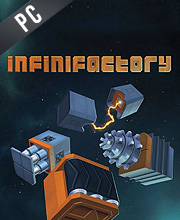


But still it is always better to promote your own business instead of someone else's (unless you're doing it to practice marketing) and at the end of the day every link to a game on Steam or a mobile app store is helping to drive more traffic to their business not yours. I'm not saying they haven't helped out some folks. I mean sure these stores have done a lot to help people connect with gamers.
#INFINIFACTORY ENDING FREE#
Then they link to their games on those sites providing a massive amount (across all of the tens of thousands developers) of free marketing happening for them.

Currently, places such as the mobile app stores and Steam have a very sweet thing going on. I agree with you completely about building traffic to your own online properties. That does nothing if nobody can find them. Well it's hardly surprising, right? I'm not sure why so many folks around here seem to not realize it (hundreds of thousands, or whatever it is, of people working on games they will actually release sooner or later) is an issue and talk about "make better games". Or, in layman terms: we've got a lot of new bad-selling games on Steam, but it didn't affect the top games, which still sell pretty well." But the distribution of sales remains pretty much the same with some minor increase in lower sales and minor decrease in the middle. Galyonkin provided a little more commentary on his findings in a post on Steam Spy's Patreon page, saying, "As you'd probably expect, we saw a lot of new games released since the last year, and they've skewed the numbers toward lower sales. This year, the 10th best-selling indie game had sold 102,000 copies. Galyonkin noted that the 10th best-selling indie game a year ago sold 104,000 copies in April. While the same trends could be seen in games with the "indie" tag, the successful indie titles appear to be doing as well as ever. A median game on Steam now has 21,000 owners, whereas a year ago that number was 32,000.Īs alarming as those numbers might be at first glance, Galyonkin emphasized that they weren't evidence of market saturation or an indiepocalypse. Last April, the average number of copies sold per game was 13,655. Galyonkin compared sales of all games on Steam from April 2015 and April 2016, finding that while the number of games offered on the storefront had increased significantly, the number of copies sold wasn't increasing in step. With the storefront tracking site having recently completed its first year of existence, creator Sergey Galyonkin took to Twitter this week to share some year-over-year findings. The Steam store has just as many happy endings for developers as ever, but an ever-increasing number of sadder stories, if the latest Steam Spy figures are anything to go by. Storefront tracker says top games sell as well as ever, but the rest of the ever-expanding catalog languishes


 0 kommentar(er)
0 kommentar(er)
